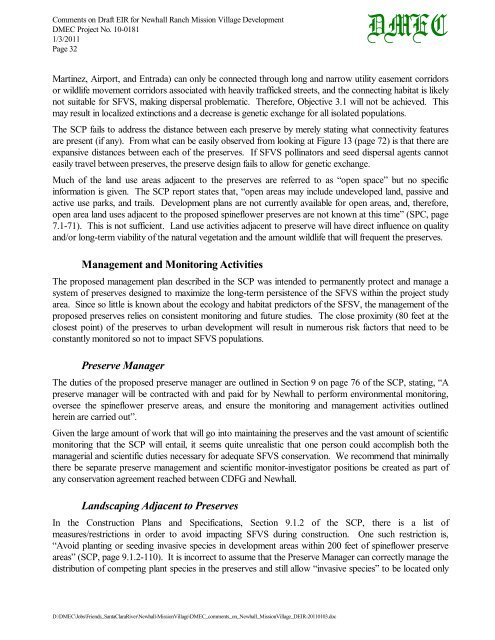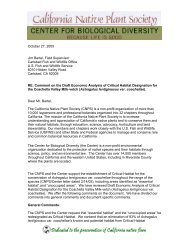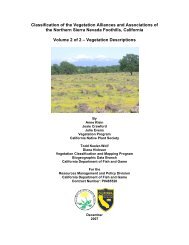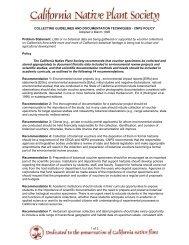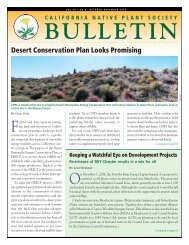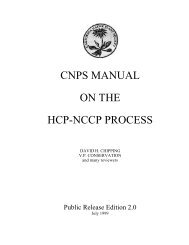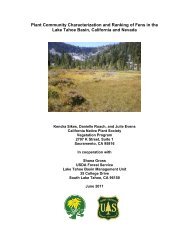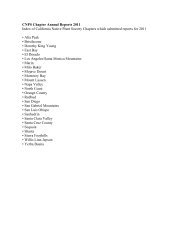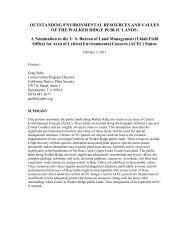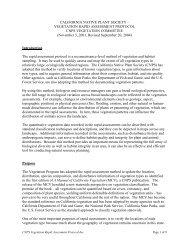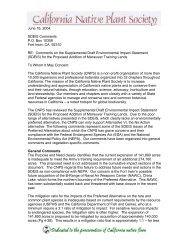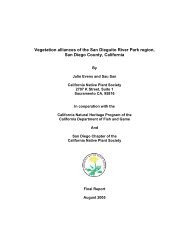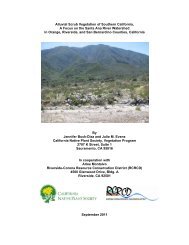David Magney Environmental Consulting - California Native Plant ...
David Magney Environmental Consulting - California Native Plant ...
David Magney Environmental Consulting - California Native Plant ...
Create successful ePaper yourself
Turn your PDF publications into a flip-book with our unique Google optimized e-Paper software.
Comments on Draft EIR for Newhall Ranch Mission Village Development<br />
DMEC Project No. 10-0181<br />
1/3/2011<br />
Page 32<br />
D:\DMEC\Jobs\Friends_SantaClaraRiver\Newhall-MissionVillage\DMEC_comments_on_Newhall_MissionVillage_DEIR-20110103.doc<br />
DMEC<br />
Martinez, Airport, and Entrada) can only be connected through long and narrow utility easement corridors<br />
or wildlife movement corridors associated with heavily trafficked streets, and the connecting habitat is likely<br />
not suitable for SFVS, making dispersal problematic. Therefore, Objective 3.1 will not be achieved. This<br />
may result in localized extinctions and a decrease is genetic exchange for all isolated populations.<br />
The SCP fails to address the distance between each preserve by merely stating what connectivity features<br />
are present (if any). From what can be easily observed from looking at Figure 13 (page 72) is that there are<br />
expansive distances between each of the preserves. If SFVS pollinators and seed dispersal agents cannot<br />
easily travel between preserves, the preserve design fails to allow for genetic exchange.<br />
Much of the land use areas adjacent to the preserves are referred to as “open space” but no specific<br />
information is given. The SCP report states that, “open areas may include undeveloped land, passive and<br />
active use parks, and trails. Development plans are not currently available for open areas, and, therefore,<br />
open area land uses adjacent to the proposed spineflower preserves are not known at this time” (SPC, page<br />
7.1-71). This is not sufficient. Land use activities adjacent to preserve will have direct influence on quality<br />
and/or long-term viability of the natural vegetation and the amount wildlife that will frequent the preserves.<br />
Management and Monitoring Activities<br />
The proposed management plan described in the SCP was intended to permanently protect and manage a<br />
system of preserves designed to maximize the long-term persistence of the SFVS within the project study<br />
area. Since so little is known about the ecology and habitat predictors of the SFSV, the management of the<br />
proposed preserves relies on consistent monitoring and future studies. The close proximity (80 feet at the<br />
closest point) of the preserves to urban development will result in numerous risk factors that need to be<br />
constantly monitored so not to impact SFVS populations.<br />
Preserve Manager<br />
The duties of the proposed preserve manager are outlined in Section 9 on page 76 of the SCP, stating, “A<br />
preserve manager will be contracted with and paid for by Newhall to perform environmental monitoring,<br />
oversee the spineflower preserve areas, and ensure the monitoring and management activities outlined<br />
herein are carried out”.<br />
Given the large amount of work that will go into maintaining the preserves and the vast amount of scientific<br />
monitoring that the SCP will entail, it seems quite unrealistic that one person could accomplish both the<br />
managerial and scientific duties necessary for adequate SFVS conservation. We recommend that minimally<br />
there be separate preserve management and scientific monitor-investigator positions be created as part of<br />
any conservation agreement reached between CDFG and Newhall.<br />
Landscaping Adjacent to Preserves<br />
In the Construction Plans and Specifications, Section 9.1.2 of the SCP, there is a list of<br />
measures/restrictions in order to avoid impacting SFVS during construction. One such restriction is,<br />
“Avoid planting or seeding invasive species in development areas within 200 feet of spineflower preserve<br />
areas” (SCP, page 9.1.2-110). It is incorrect to assume that the Preserve Manager can correctly manage the<br />
distribution of competing plant species in the preserves and still allow “invasive species” to be located only


